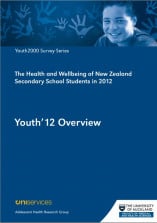Key statistics
- Hazardous drinking rates peak in the 18–24-year age group. One-third of 18–24-year olds (33%) are hazardous drinkers. (1)
- There has been a dramatic increase in the global prevalence of obesity.
- In 2012 New Zealand adults ranked third highest out of 15 OECD countries for measures of obesity and in 2010 New Zealand children (aged 5–17 years) ranked third highest out of 40 countries for overweight (including obesity). (2)
- Adults and children living in the most deprived areas have higher rates of all health risks including smoking, hazardous drinking and obesity. (1)
- Unmet need for primary health care is more common among Māori and Pacific adults and children, and in those living in the most deprived areas (1)
Youth Survey Series
A series of surveys of Year 10 students has been conducted in New Zealand since 2000.(3) Led by the University of Auckland, the Youth2000 survey series(external link) (University of Auckland) ask a large, representative sample of secondary school students from over approximately a third of all high school in New Zealand a wide range of questions that contribute to health and wellbeing of young people in New Zealand.
These include questions about:
- ethnicity & culture,
- physical health,
- food & activities,
- substance use,
- sexual health,
- injuries and violence,
- home and family health,
- school achievement and participation,
- neighbourhood environment,
- spirituality and
- access to healthcare.
This series provides invaluable information about health, wellbeing and trends in this age group. In the latest survey of 2012(external link), the areas of health and wellbeing where students report little or no change include:
- Inconsistent condom and contraception use
- Being bullied
- Being overweight or obese
- Youth not feeling they spend enough time with at least one parent
- Youth experiencing significant depressive symptoms
Areas that have significantly worsened over the last decade as shown by the Youth Survey Series including:
- Parents worrying about having enough money for food
- Access to a family doctor
- Participation in paid part-time employment.
Te Ohonga Ake Reporting Series
The New Zealand Child and Youth Epidemiology Service provide annual reports to participating District Health Boards (DHBs) since 2005 to assist with DHBs' 3-yearly Health Needs Assessments.
Each three year reporting cycle aims to provide a comprehensive overview of child and youth health, using an Indicator Framework(external link) developed specifically for this purpose. Within each cycle, issues are covered in the following order:
- Year 1: The Health Status of Children and Young People
- Year 2: The Determinants of Child and Youth Health
- Year 3: Children and Young People with Chronic Conditions and Disabilities
In 2010, the Ministry of Health commissioned some additional reports to provide an overview of health issues for Māori children and young people.
- The Health Status of Māori Children and Young People in New Zealand(external link) 2012
- The Health of Māori Children and Young People with Chronic Conditions and Disabilities in New Zealand(external link) 2012
- The Determinants of Health for Māori Children and Young People in New Zealand(external link) 2012
These issues are exacerbated by barriers to accessing health services, low income and frequent relocation.
Mental Health Youth Project
The Prime Minister’s Youth Mental Health Project (YMHP) was launched in 2012. This project is an intersectoral initiative that "aims to help prevent the development of mental health issues and improve young people’s access to youth mental health services." It was established in response to a report from the Prime Minister’s Chief Science Advisor, Improving the Transition: Reducing Social and Psychological Morbidity During Adolescence(external link) which raised concerns about significant levels of mental health issues occurring during the transition period from childhood to adulthood including depression and other mental health disorders, harmful use of alcohol, cannabis use and youth suicide.
Some of the initiatives to promote youth mental health include:
- SPARX(external link) – A self-help e-therapy tool in an online game-style format that young people can use in their own space.
- Common Ground(external link) – A place for family, whānau and friends to help our young people enjoy positive mental health and wellbeing.
- Lifehack(external link) – The team runs a social innovation lab and incubator weekends to co-create projects that promote young people’s wellbeing.
- Aunty Dee – A New Zealand based wellbeing tool to help people cope with stressful life experiences through support with problem solving. Although anyone can use the tool, it is aimed at Pacific and Maori young people aged 14-25 years.
Evaluation of the Youth Mental Health Project
In May 2015, Superu released a research review and a formative evaluation of the Youth Mental Health Project. A summative report of all the projects will be completed in 2016.
View the formative evaluation report summary(external link)
View the research review(external link)
View the formative evaluation report(external link)
Mental health article
Time to focus on youth mental health(external link) He Ako Hiringa, NZ, 2023




